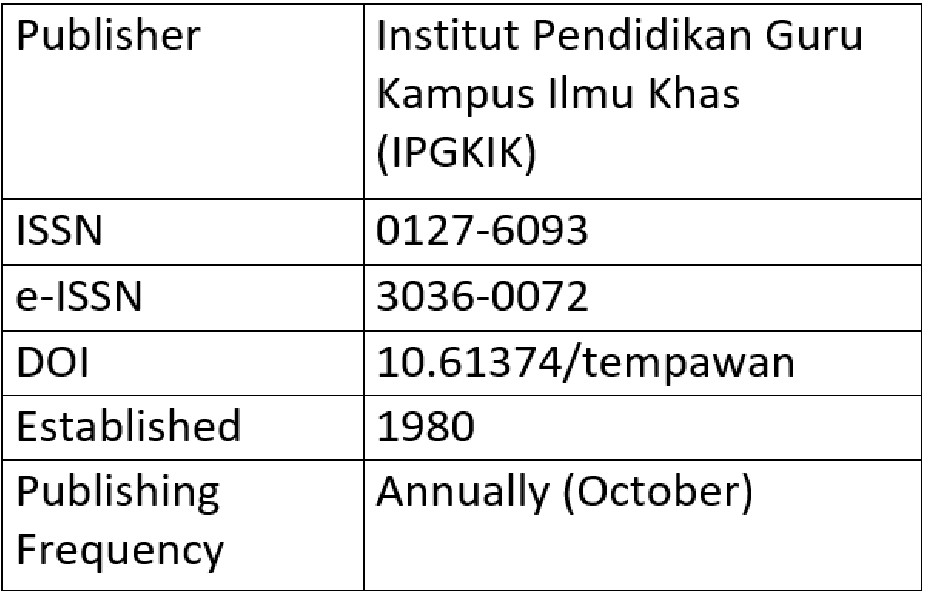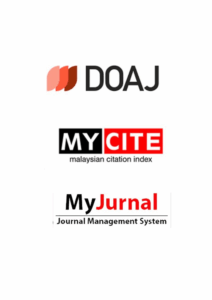1.0 OBJECTIVE
These guidelines are provided as a guide for publishing manuscripts of the TEMPAWAN journal published by the Institute of Teacher Education Ilmu Khas Campus (IPGKIK) under the responsibility of the Department of Planning, Research and Innovation (JPPI).
2.0 INTRODUCTION
TEMPAWAN is an international journal concerned primarily with teachers, teaching, and/or teacher education situated in an international perspective and context. This journal is a double-blind peer-reviewed journal and is published once a year (November). The journal focuses on early childhood through secondary education, teacher preparation, teacher professional development and/or teacher education. TEMPAWAN is a multidisciplinary journal committed to no single approach, discipline, methodology, or paradigm. The journal welcomes varied approaches (qualitative, quantitative, and mixed methods) to empirical research as well as systematic reviews and meta-analyses.
Accepted manuscripts are based on research and development work in the field of education. The content of the manuscript should be in the following form:
a) empirical research;
b) discoveries, methods or new applications;
c) critical evaluations; and
d) concept paper
3.0 ACCEPTANCE REQUIREMENTS
Submitted manuscripts must not have been published in any journal, proceeding or, it is not under consideration for publication elsewhere. The manuscript must be sent in the form of a soft copy (softcopy) of Microsoft Word format in accordance with the format as stated in 4.0. and 5.0. Manuscripts that do not comply with the writing format will be rejected.
4.0 WRITING FORMAT
All research articles including action research should follow the format set in these guidelines.
The length of the article must be between 4000 to 6000 words or 10 to 15 pages including references in compliance with the American Psychological Association (APA) 7th Edition. The size of the manuscript in A4 paper must use the following margins:
a. Top: 2.54 cm
b. Bottom: 2.54 cm
c. Left: 2.54 cm
d. Right: 2.54 cm
Manuscripts must be typed using the Times New Roman font according to the specified specifications.
PREPARATION
4.1 TITLE
The title should be short and concise. The title must be written in two languages, namely Malay and English.
Under the title, the full name of the author/authors of the manuscript must be written. The name of each author must be accompanied by the name of the institution/organization along with an email address.
i. Manuscript title
a. Size: 12 point
b. Bold & Uppercase
c. Centered
ii. Author’s name
a. Size: 11 point
b. Italic
c. Centered
iii. Author’s information (Institution dan email)
a. Size: 11 point
b. Italic & Title Case
c. Centered
4.2 ABSTRACT
The abstract is a concise synopsis of the manuscript that includes aspects of the problem, objectives, methods, and findings as well as conclusions. Abstracts must not exceed 200 words and must be written using Italic format, size 11, and Justified. Abstracts must be prepared in two languages, namely Malay and English.
4.3 KEYWORDS
The author should provide three to five keywords after the Abstract. It is intended to facilitate the search for information. Keywords should be written using Times New Roman format, size 11, and Justified.
4.4 CONTENT
Manuscripts should contain the following sections namely Introduction, Literature Review, Methods, Results, Discussion, and Conclusion. Each section can be given an appropriate title. The title should be written using Bold format, size 12, and Justified. The manuscript text is written using Normal format, size 11, and Justified.
Each table and diagram needs to be consulted first before being presented and followed by information related to the table and diagram. Tables and diagrams should be completed, concise, and clear as well as be given appropriate titles. The table or diagram should also be numbered regularly such as Table 1, Table 2 and so on, or Figure 1, Figure 2, and so on. The table title should be placed at the top of the table, while the figure title should be placed at the bottom of the figure (according to the APA 7th edition format).
4.5 ACKNOWLEDGEMENTS
Acknowledgements of no more than 50 words, if any, should be placed at the end of the manuscript before the references section.
4.6 DISCLOSURE OF CONFLICT OF INTEREST
All authors are requested to disclose any actual or potential conflict of interest including any financial, personal or other relationships with other people or organizations that could inappropriately influence, or be perceived to influence, their work. If there is no conflict of interest, a statement should be written at the end of the manuscript.
Example:
Disclosure statement
No potential conflict of interest was reported by the authors.
4.7 REFERENCES
All references cited in the text must be listed. The reference list should not contain sources that are not referenced in the manuscript. A complete reference list should use the author-date system alphabetically. A list of references should be placed at the end of a manuscript.
The reference writing style is in accordance with APA Citation Style 7th edition. References are written using Normal format, size 11, and Justified. Please refer to 6.0 for specific reference examples.
5.0 SPECIFICATIONS
Apart from the guidelines listed in 4.0 above, authors are requested to adhere to the following guidelines in writing the manuscript.
i. The author’s name should be placed under the title of the manuscript with two lines between them.
ii. Further information such as institution and email should be placed under the author’s name on the first page of the manuscript.
iii. The distance between the Title and the Author’s Name and the Abstract and between the abstract and the first line of the text is two lines.
iv. The distance between the subtitle and the last line of the previous text is one line.
v. The distance between the subtitle and the first line of text after it is one line.
vi. Spacing between paragraphs is one line.
vii. Start the subtitle with its number from the left margin.
viii. Start the first line of a paragraph with NO spacing from the left margin.
ix. The distance between the last sentence and the Table, Figure, or illustration is one line.
x. Line Spacing is 1.
6.0 REFERENCE EXAMPLES
Text: Citations in the text should follow the referencing style used by the American Psychological Association. You are referred to the Publication Manual of the American Psychological Association, Seventh Edition.
List: References should be arranged first alphabetically and then further sorted chronologically if necessary. More than one reference from the same author(s) in the same year must be identified by the letters ‘a’, ‘b’, ‘c’, etc., placed after the year of publication.
Examples:
Reference to a journal publication:
Ruxton, C. (2016). Tea: Hydration and other health benefits. Primary Health Care, 26(8), 34-42. https://doi.org/10.7748/phc.2016.e1162
Reference to a book:
Creswell, J. W. (2012). Educational research: Planning, conducting, and evaluating quantitative and qualitative research. (4th ed.). PHI Learning Private Limited.
Reference to an unpublished thesis:
Muhaya Salleh. (2016). Keberkesanan latihan praktikum berasaskan kepada perkembangan identiti profesional guru pelatih di institut pendidikan guru Malaysia. [Tesis kedoktoran yang tidak diterbitkan]. Universiti Sains Malaysia.
Reference to a chapter in an edited book:
Mettam, G. R., & Adams, L. B. (2009). How to prepare an electronic version of your article. In B. S. Jones, & R. Z. Smith (Eds.), Introduction to the electronic age (pp. 281-304). E-Publishing Inc.
Reference to a website:
Powertech Systems. (2015). Lithium-ion vs lead-acid cost analysis. Retrieved from http://www.powertechsystems.eu/home/tech-corner/lithium-ion-vs-lead-acid-cost-analysis/. Accessed January 6, 2016.
Reference to a conference paper or poster presentation:
Engle, E. K., Cash, T. F., & Jarry, J. L. (2009, November). The body image behaviours inventory-3: Development and validation of the body image compulsive actions and body image avoidance scales. Poster session presentation at the meeting of the Association for Behavioural and Cognitive Therapies, New York, NY.
Please note that it is the authors’ responsibility to ensure that referencing is consistent with APA (7th) as per the examples above. Manuscripts that are not consistent with APA (7th) may be rejected without review.
7.0 COPYRIGHT
Manuscripts published in TEMPAWAN Journal are the property of IPGKIK. IPGKIK reserves the right to republish this manuscript in various forms for scientific purposes. The authors who have acknowledged the published manuscript are responsible for its content.
8.0 SUBMISSION OF MANUSCRIPT
Before submitting the manuscript, please use the checklist in Appendix 1. Authors are encouraged to get opinions from lecturers or other experts before submitting their articles. Manuscripts should be sent out before 1 April via email in the format set out in this guide to:
Planning, Research, and Innovation Department
Institute of Teacher Education Ilmu Khas Campus
email: tempawan@ipgkik.edu.my
Please download the softcopy of the Manuscript Writing Guidelines
Boleh muat turun Panduan Penulisan Artikel
Download TEMPAWAN Article Template
Muat turun Templat Artikel TEMPAWAN







